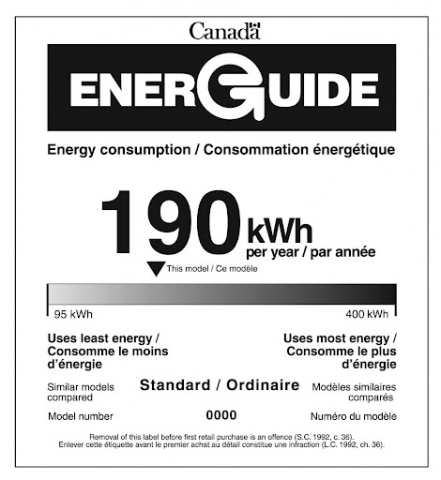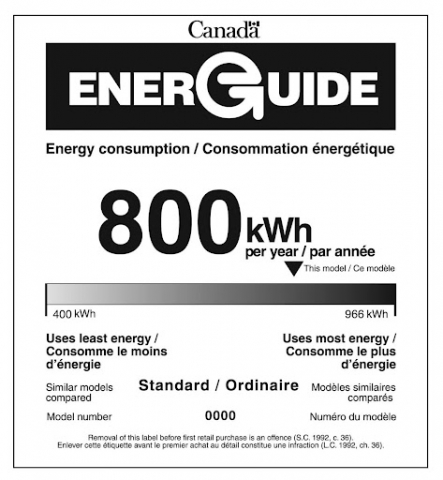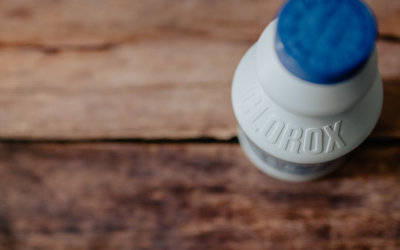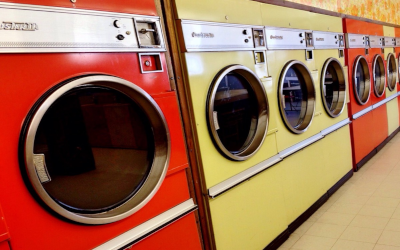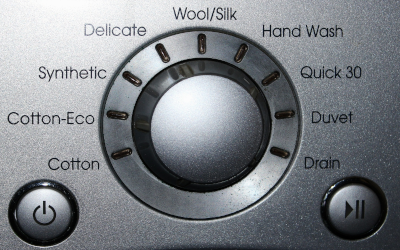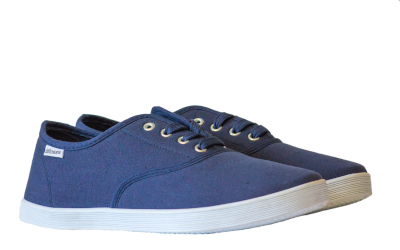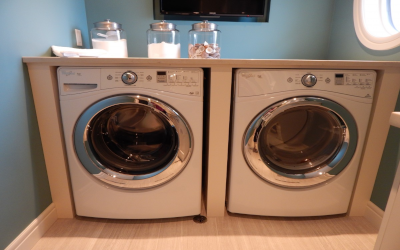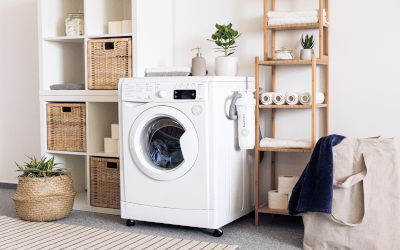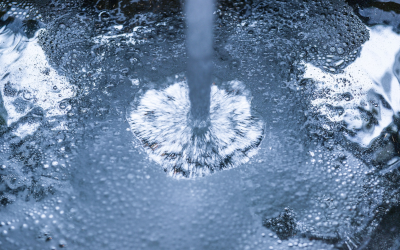
Understanding Clothing Care Symbols
What You Need
- Piece of clothing with clothing label attached
- Chart below
What To Do
You have probably seen the labels in your clothes. They might be sewn on or printed on. These tiny tags give you some very important information about the item of clothing.

One part of the label tells you about the size of the clothing. You can also learn what the clothing is made of (the fibre content) as well as where it was made.
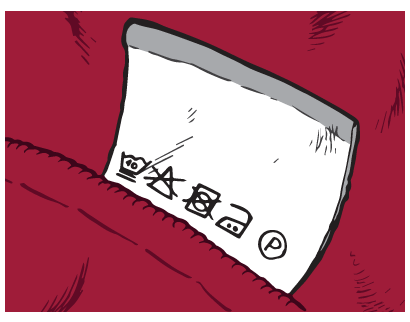
Shown is a colour comic-style illustratration of the back of a clothing label, printed with five clothing care symbols.
The label is white, and appears to be sewn into the collar of a red t-shirt.
The first symbol is a line drawing of a bucket of water with the number 40 written inside it. There are two lines underneath the bucket. The second is an equilateral triangle with a large X drawn across it. The third is a square, with a large circle inside it. This also has an X drawn across it. The fourth is a line drawing of an iron with two black polka dots inside it. The fifth is a circle with the letter P written inside.
Image - Text Version
Shown is a colour comic-style illustratration of the back of a clothing label, printed with five clothing care symbols.
The label is white, and appears to be sewn into the collar of a red t-shirt.
The first symbol is a line drawing of a bucket of water with the number 40 written inside it. There are two lines underneath the bucket. The second is an equilateral triangle with a large X drawn across it. The third is a square, with a large circle inside it. This also has an X drawn across it. The fourth is a line drawing of an iron with two black polka dots inside it. The fifth is a circle with the letter P written inside.
The other part of the label gives you information about how to care for the piece of clothing. Following the care instructions keeps the clothes lasting longer. It also helps reduce greenhouse gas emissions and water use.
This information may be given as words, or symbols, or both
Find this information on your tag.
Next, look at the washing instructions chart to learn what each symbol means.
Washing Instructions
People wash most of their clothes themselves using a washing machine.
- The container of water is the symbol for a washing machine.
- One line below the symbol means to set the machine on a permanent press cycle.
- Two lines means to set it on a gentle cycle.
- A hand means to hand wash.
- An X means not to wash. Clothes with this symbol need to be dry cleaned.
Image ©2021 Let’s Talk Science
Image - Text Version
Shown is a colour illustration of six black, line drawing-style clothing care symbols on a yellow background.
All but one of the symbols are based on the same line drawing of a bucket of water. It is wide with an open top, where waves are visible on the surface. There are two rows of three symbols each.
From the top left, the first symbol is a line drawing of a bucket of water. It is wide with an open top, where waves are visible on the surface of the water. This is labelled “machine wash.” The second symbol is the same bucket, with an extra, horizontal line under the bottom of the bucket. This is labelled “machine wash, permanent press.” The third is the same bucket again, but with two horizontal lines under the bucket. This is labelled “machine wash, gentle or delicate.”
On the bottom row, starting on the left, the fourth symbol is the same bucket, with the black silhouette of a hand dipping into the water. This is labelled “hand wash.” The fifth symbol is the bucket with a large X drawn across it. This is labelled “do not wash.” The final symbol, on the bottom right, is a line drawing of a piece of fabric, twisted several times. A large X is drawn through this. It is labelled “do not wring.”
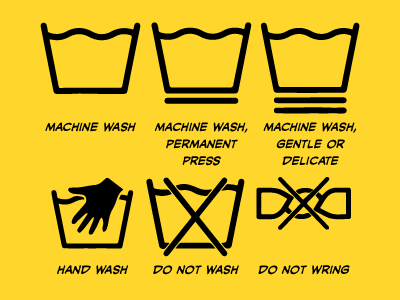
The washing symbol may also have a temperature listed or a dot. The more dots, the hotter the maximum temperature for washing can be.
Image ©2021 Let’s Talk Science
Image - Text Version
Shown is a colour illustration of 12 black, line drawing-style clothing care symbols on an orange background.
All the symbols are based on the same line drawing of a bucket of water. It is wide with an open top, where waves are visible on the surface. There are four rows of three symbols each.
From the top left, the first symbol has 30° written inside the bucket. The second has 40° written inside it. The third has 50° inside it.
In the second row, the first symbol has one black polka dot in the bucket. This is labelled, underneath, with the words “30°C or 80°F.” The second symbol has two black dots, in a row. This is labelled “40°C or 105°F.” The third has three black dots in a row. This is labelled “50°C or 120°F.”
In the third row, the first symbol has 60° written inside the bucket. The second has 70° written inside. The third has 95°. No symbols on this row are labelled.
In the fourth and final row, the first symbol has four black polka dots. It is labelled “60°C or 140°F.” The second symbol has five black dots. It is labelled “70°C or 160°F.” The third symbol has six black dots. It is labelled “95°C or 200°F.”
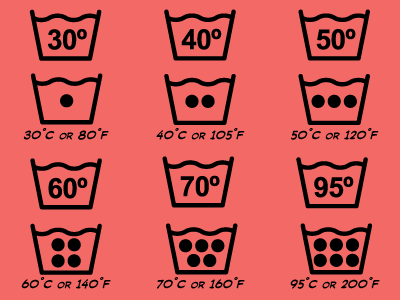
Sometimes people use bleach to disinfect and whiten clothes. The symbol for bleach is a triangle.
Many laundry bleaches are chlorine bleaches. Chlorine bleach is a water solution of sodium hypochlorite.
Bleach can remove the dye from clothing. That is why it is important to check for this symbol before using any type of bleach.
Image ©2021 Let’s Talk Science
Image - Text Version
Shown is a colour illustration of four black, line drawing style clothing care symbols on a pale purple background.
All the symbols are based on the same line drawing of an equilateral triangle. Each one is labelled with black text underneath. There are two rows with two symbols each.
Starting from the top left, the first symbol is the equilateral triangle alone. This is labelled with the words “Bleach if needed.” The second symbol is the same triangle with a large X drawn across it. This is labelled “Do not bleach.”
In the second row, starting on the left, the first symbol has two black lines drawn diagonally in the triangle, angled from top right to bottom left. This is labelled “Non-chlorine bleach if needed.” The second and final symbol is the triangle with the capital letters “CL” written inside. A large X is drawn across the whole symbol. This is also labelled “Non-chlorine bleach if needed.”
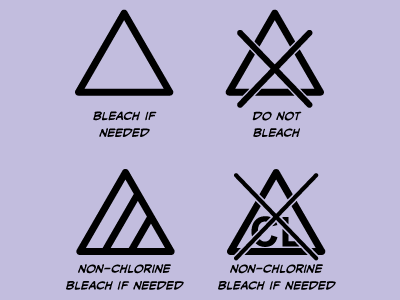
Wet clothes need to be dried. The symbol for how to dry your clothes is a square.
- A circle inside the square means an electric dryer. The number of dots shows how hot the dryer can be.
- Lines show how to hang clothes for air drying when not using a clothes dryer.
- An X means do not dry a certain way, or do not dry at all.
Image ©2021 Let’s Talk Science
Image - Text Version
Shown is a colour illustration of 12 black, line drawing-style clothing care symbols on a pale blue background.
Each symbol is based on the same black line drawing of a square, labelled underneath with black text. There are three rows with four symbols each.
Starting on the top left, the first symbol is the square alone. It is labelled “Dry.” The second symbol is the square with a large circle inside it, and a black polka dot inside that. This is labelled “Dry normal, low heat.” The third symbol is the same square with the circle inside, and two dots in the centre. This is labelled “Dry normal, medium heat.” The fourth symbol is the same, but with three dots in the centre. This is labelled “Dry normal, high heat.”
In the second row, the first symbol is the square, with a curved line from the top left to the top right corner. This is labelled “Hang to dry.” The second symbol is the square with three vertical lines inside it. This is labelled “Drip dry.” The third has one horizontal line inside the square. It is labelled “Dry flat.” In the fourth symbol, there are two diagonal lines across the top left corner of the square. This is labelled “Dry in the shade.”
In the third row, the first symbol is the square with a large X drawn across it. This is labelled “Do not dry.” The second symbol is the square with a large circle inside it. This also has a large X across it. It is labelled “Do not tumble dry.” The third symbol is the same, but the circle is filled in with black. This is labelled “Dry normal, no heat.” The fourth and final symbol is the square with an empty circle inside. This is labelled “Tumble dry.”
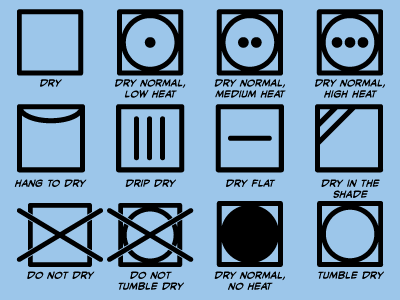
Some types of fabrics can be wrinkly after drying or wearing. To get wrinkles out, people may use an electric iron. The symbol for ironing is an electric iron shape.
- The number of dots shows how hot the iron can be
- An X means do not iron, or do not use steam when ironing.
Image ©2021 Let’s Talk Science
Image - Text Version
Shown is a colour illustration of six black, line-drawing style clothing care symbols on a pink background.
All the symbols are based on a basic line drawing of an iron with a handle on top and a long rounded piece with a flat bottom below. Each one is labelled with black text underneath. There is one row of four symbols along the top, and a row with two symbols on the bottom, to the left.
In the top left corner, the first symbol is the iron alone. This is labelled “Iron, any temp, steam.” To the right, the second symbol is the iron, with one black polka dot in the centre of the base. This is labelled “Maximum temperature 110°C / 230°F.” The third is the same, but with two black dots, in a row. This is labelled “Maximum temperature 150°C / 300°F.” The fourth is the same again, but with a row of three black dots. This is labelled “Maximum temperature 200°C / 390°F.”
In the second row, the first symbol is the iron with a large X drawn across it. This is labelled “Do not iron.” The second and final symbol is the iron with two diagonal lines spreading out from the flat bottom. An is drawn across this area. The label below reads “No steam.”

Some clothes should not be washed in washing machines. These clothes need to be “dry cleaned” using a chemical process. Dry cleaning is done by businesses that specialize in cleaning clothes this way.
- A circle means that something needs to be dry cleaned.
- Letters inside the circles show what types of chemicals can be used to clean the clothing.
- Lines beside the circle show what type of dry cleaning.
- An X means do not dry clean.
Image ©2021 Let’s Talk Science
Image - Text Version
Shown is a colour illustration of ten black, line-drawing style clothing care symbols on a pale green background. Each symbol is based on an empty circle. There are two rows of four symbols, and a third row with two symbols.
Starting on the top left, the first symbol is the circle alone. This is labelled “Dryclean.” To the right, the second is the same circle, with a large X across it. This is labelled “Do not dryclean.” The third symbol is the circle with a capital letter W in the centre. This is labelled “Wet cleaning.” The fourth is the same, but with a capital letter A in the centre. This is labelled “Any solvent.”
In the second row, the first symbol is the circle, with a short diagonal line below it, on the bottom right. This is labelled “Low heat.” The second is the same, but the line is above, on the top right. This is labelled “No steam finishing.” The third has the line on the top left. This is labelled “Reduced moisture.” The fourth symbol is the circle with a capital letter F in the centre. It is labelled “Petroleum solvent only.”
In the third row, the first symbol is the circle with the diagonal line to the bottom left. This is labelled “Short cycle.” The third and final symbol is the circle with a capital letter P in the centre. This is labelled “Any solvent except tetrachlorethylene.”
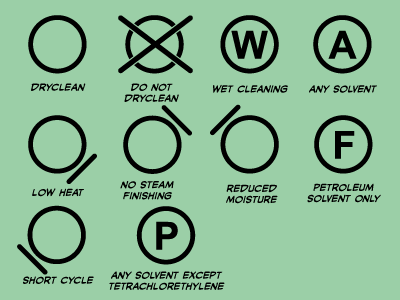
People wash most of their clothes themselves using a washing machine.
- The container of water is the symbol for a washing machine.
- One line below the symbol means to set the machine on a permanent press cycle.
- Two lines means to set it on a gentle cycle.
- A hand means to hand wash.
- An X means not to wash. Clothes with this symbol need to be dry cleaned.
Image ©2021 Let’s Talk Science
Image - Text Version
Shown is a colour illustration of six black, line drawing-style clothing care symbols on a yellow background.
All but one of the symbols are based on the same line drawing of a bucket of water. It is wide with an open top, where waves are visible on the surface. There are two rows of three symbols each.
From the top left, the first symbol is a line drawing of a bucket of water. It is wide with an open top, where waves are visible on the surface of the water. This is labelled “machine wash.” The second symbol is the same bucket, with an extra, horizontal line under the bottom of the bucket. This is labelled “machine wash, permanent press.” The third is the same bucket again, but with two horizontal lines under the bucket. This is labelled “machine wash, gentle or delicate.”
On the bottom row, starting on the left, the fourth symbol is the same bucket, with the black silhouette of a hand dipping into the water. This is labelled “hand wash.” The fifth symbol is the bucket with a large X drawn across it. This is labelled “do not wash.” The final symbol, on the bottom right, is a line drawing of a piece of fabric, twisted several times. A large X is drawn through this. It is labelled “do not wring.”

The washing symbol may also have a temperature listed or a dot. The more dots, the hotter the maximum temperature for washing can be.
Image ©2021 Let’s Talk Science
Image - Text Version
Shown is a colour illustration of 12 black, line drawing-style clothing care symbols on an orange background.
All the symbols are based on the same line drawing of a bucket of water. It is wide with an open top, where waves are visible on the surface. There are four rows of three symbols each.
From the top left, the first symbol has 30° written inside the bucket. The second has 40° written inside it. The third has 50° inside it.
In the second row, the first symbol has one black polka dot in the bucket. This is labelled, underneath, with the words “30°C or 80°F.” The second symbol has two black dots, in a row. This is labelled “40°C or 105°F.” The third has three black dots in a row. This is labelled “50°C or 120°F.”
In the third row, the first symbol has 60° written inside the bucket. The second has 70° written inside. The third has 95°. No symbols on this row are labelled.
In the fourth and final row, the first symbol has four black polka dots. It is labelled “60°C or 140°F.” The second symbol has five black dots. It is labelled “70°C or 160°F.” The third symbol has six black dots. It is labelled “95°C or 200°F.”

Sometimes people use bleach to disinfect and whiten clothes. The symbol for bleach is a triangle.
Many laundry bleaches are chlorine bleaches. Chlorine bleach is a water solution of sodium hypochlorite.
Bleach can remove the dye from clothing. That is why it is important to check for this symbol before using any type of bleach.
Image ©2021 Let’s Talk Science
Image - Text Version
Shown is a colour illustration of four black, line drawing style clothing care symbols on a pale purple background.
All the symbols are based on the same line drawing of an equilateral triangle. Each one is labelled with black text underneath. There are two rows with two symbols each.
Starting from the top left, the first symbol is the equilateral triangle alone. This is labelled with the words “Bleach if needed.” The second symbol is the same triangle with a large X drawn across it. This is labelled “Do not bleach.”
In the second row, starting on the left, the first symbol has two black lines drawn diagonally in the triangle, angled from top right to bottom left. This is labelled “Non-chlorine bleach if needed.” The second and final symbol is the triangle with the capital letters “CL” written inside. A large X is drawn across the whole symbol. This is also labelled “Non-chlorine bleach if needed.”

Wet clothes need to be dried. The symbol for how to dry your clothes is a square.
- A circle inside the square means an electric dryer. The number of dots shows how hot the dryer can be.
- Lines show how to hang clothes for air drying when not using a clothes dryer.
- An X means do not dry a certain way, or do not dry at all.
Image ©2021 Let’s Talk Science
Image - Text Version
Shown is a colour illustration of 12 black, line drawing-style clothing care symbols on a pale blue background.
Each symbol is based on the same black line drawing of a square, labelled underneath with black text. There are three rows with four symbols each.
Starting on the top left, the first symbol is the square alone. It is labelled “Dry.” The second symbol is the square with a large circle inside it, and a black polka dot inside that. This is labelled “Dry normal, low heat.” The third symbol is the same square with the circle inside, and two dots in the centre. This is labelled “Dry normal, medium heat.” The fourth symbol is the same, but with three dots in the centre. This is labelled “Dry normal, high heat.”
In the second row, the first symbol is the square, with a curved line from the top left to the top right corner. This is labelled “Hang to dry.” The second symbol is the square with three vertical lines inside it. This is labelled “Drip dry.” The third has one horizontal line inside the square. It is labelled “Dry flat.” In the fourth symbol, there are two diagonal lines across the top left corner of the square. This is labelled “Dry in the shade.”
In the third row, the first symbol is the square with a large X drawn across it. This is labelled “Do not dry.” The second symbol is the square with a large circle inside it. This also has a large X across it. It is labelled “Do not tumble dry.” The third symbol is the same, but the circle is filled in with black. This is labelled “Dry normal, no heat.” The fourth and final symbol is the square with an empty circle inside. This is labelled “Tumble dry.”

Some types of fabrics can be wrinkly after drying or wearing. To get wrinkles out, people may use an electric iron. The symbol for ironing is an electric iron shape.
- The number of dots shows how hot the iron can be
- An X means do not iron, or do not use steam when ironing.
Image ©2021 Let’s Talk Science
Image - Text Version
Shown is a colour illustration of six black, line-drawing style clothing care symbols on a pink background.
All the symbols are based on a basic line drawing of an iron with a handle on top and a long rounded piece with a flat bottom below. Each one is labelled with black text underneath. There is one row of four symbols along the top, and a row with two symbols on the bottom, to the left.
In the top left corner, the first symbol is the iron alone. This is labelled “Iron, any temp, steam.” To the right, the second symbol is the iron, with one black polka dot in the centre of the base. This is labelled “Maximum temperature 110°C / 230°F.” The third is the same, but with two black dots, in a row. This is labelled “Maximum temperature 150°C / 300°F.” The fourth is the same again, but with a row of three black dots. This is labelled “Maximum temperature 200°C / 390°F.”
In the second row, the first symbol is the iron with a large X drawn across it. This is labelled “Do not iron.” The second and final symbol is the iron with two diagonal lines spreading out from the flat bottom. An is drawn across this area. The label below reads “No steam.”

Some clothes should not be washed in washing machines. These clothes need to be “dry cleaned” using a chemical process. Dry cleaning is done by businesses that specialize in cleaning clothes this way.
- A circle means that something needs to be dry cleaned.
- Letters inside the circles show what types of chemicals can be used to clean the clothing.
- Lines beside the circle show what type of dry cleaning.
- An X means do not dry clean.
Image ©2021 Let’s Talk Science
Image - Text Version
Shown is a colour illustration of ten black, line-drawing style clothing care symbols on a pale green background. Each symbol is based on an empty circle. There are two rows of four symbols, and a third row with two symbols.
Starting on the top left, the first symbol is the circle alone. This is labelled “Dryclean.” To the right, the second is the same circle, with a large X across it. This is labelled “Do not dryclean.” The third symbol is the circle with a capital letter W in the centre. This is labelled “Wet cleaning.” The fourth is the same, but with a capital letter A in the centre. This is labelled “Any solvent.”
In the second row, the first symbol is the circle, with a short diagonal line below it, on the bottom right. This is labelled “Low heat.” The second is the same, but the line is above, on the top right. This is labelled “No steam finishing.” The third has the line on the top left. This is labelled “Reduced moisture.” The fourth symbol is the circle with a capital letter F in the centre. It is labelled “Petroleum solvent only.”
In the third row, the first symbol is the circle with the diagonal line to the bottom left. This is labelled “Short cycle.” The third and final symbol is the circle with a capital letter P in the centre. This is labelled “Any solvent except tetrachlorethylene.”

Check Your Understanding
See how many of these symbols you remember.
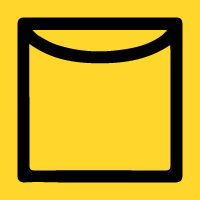
Hang to dry
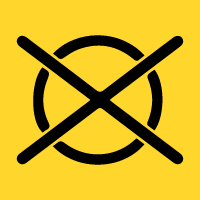
Do not dry clean
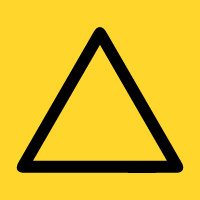
Bleach if needed
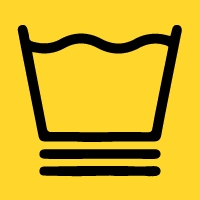
Machine wash gentle or delicate cycle

Iron maximum temp 200℃
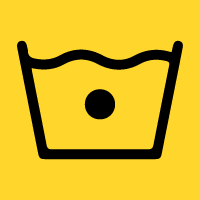
Wash maximum 30 ℃
Go Further
- Did any of the care instructions surprise you? If so, which ones?
- Do you feel that people use the care instructions as much as they could? What would help them to do so?
- How can looking at the label on a piece of clothes help you buy better?
Reflect
- Did any of the care instructions surprise you? If so, which ones?
- Do you feel that people use the care instructions as much as they could? What would help them to do so?
- How can looking at the label on a piece of clothes help you buy better?
Devices such as washing machines and dryers use electricity. Depending on where you live, this electricity may be generated using fossil fuels. Fossil fuel generating stations emit greenhouse gases (or GHGs) into the air. These GHGs contribute to climate change. Using electrical appliances less helps to fight climate change.
Although many clothes can be washed and dried at high temperatures, they do not need to be. The hotter the temperature, the more energy and electricity is required. That is why it is best to wash clothes and dry clothes at the lowest temperature possible.
Washing smarter can also help ecosystems. Lower temperatures can help prevent microfibres from being released into the environment. By choosing clothes that do not need to be dry cleaned, these chemicals can be avoided. By washing less, fewer phosphates from detergents end up in aquatic ecosystems.
Finally, by treating your clothes well, they will last much longer - and you will not need to buy clothes as often - which is also good for the environment!
Why Does It Matter?
Devices such as washing machines and dryers use electricity. Depending on where you live, this electricity may be generated using fossil fuels. Fossil fuel generating stations emit greenhouse gases (or GHGs) into the air. These GHGs contribute to climate change. Using electrical appliances less helps to fight climate change.
Although many clothes can be washed and dried at high temperatures, they do not need to be. The hotter the temperature, the more energy and electricity is required. That is why it is best to wash clothes and dry clothes at the lowest temperature possible.
Washing smarter can also help ecosystems. Lower temperatures can help prevent microfibres from being released into the environment. By choosing clothes that do not need to be dry cleaned, these chemicals can be avoided. By washing less, fewer phosphates from detergents end up in aquatic ecosystems.
Finally, by treating your clothes well, they will last much longer - and you will not need to buy clothes as often - which is also good for the environment!
- Find an EnerGuide label on a washing machine or dryer. These labels are mandatory for washing machines and dryers sold in Canada. Use this value to estimate the energy used for a single load of clothing.
- Learn about how chemicals such as laundry detergents impact aquatic ecosystems.
- Compare the properties of chlorine and non-chlorine bleaches.
- Investigate what chemicals and processes are used in dry cleaning.
Investigate
- Find an EnerGuide label on a washing machine or dryer. These labels are mandatory for washing machines and dryers sold in Canada. Use this value to estimate the energy used for a single load of clothing.
- Learn about how chemicals such as laundry detergents impact aquatic ecosystems.
- Compare the properties of chlorine and non-chlorine bleaches.
- Investigate what chemicals and processes are used in dry cleaning.
